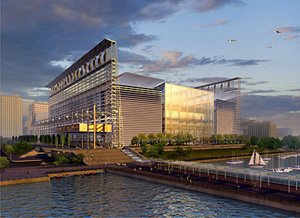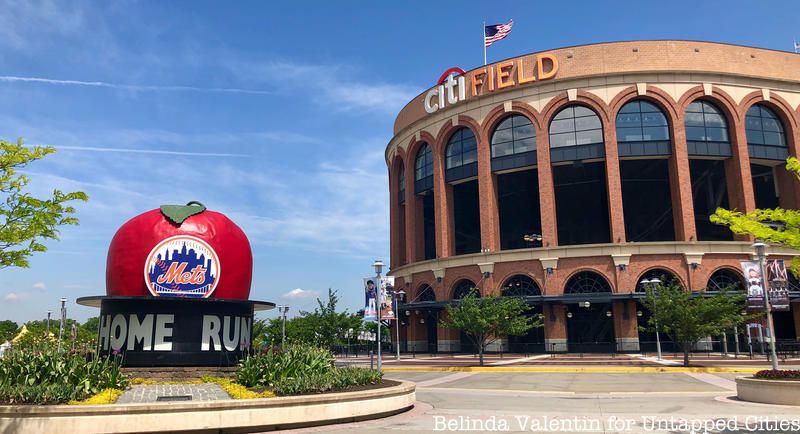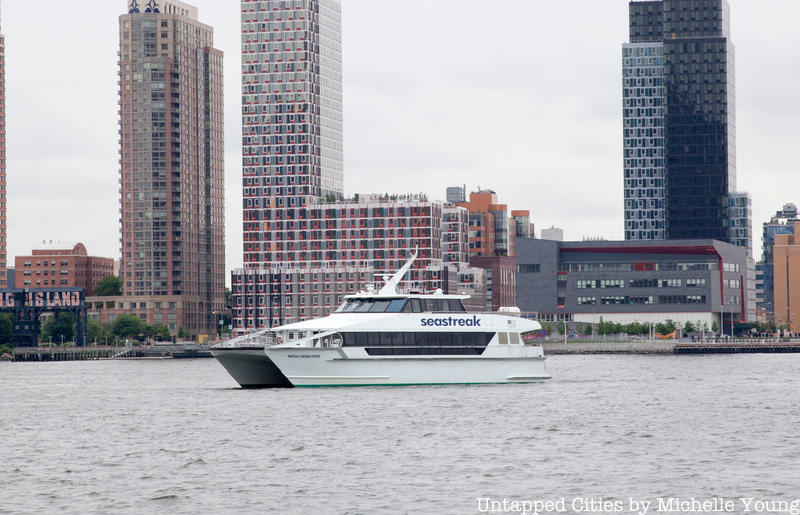Last Chance to Catch NYC's Holiday Notalgia Train
We met the voices of the NYC subway on our nostalgia ride this weekend!


The Olympic Games seem to have come and gone in the blink of an eye. But their impact on the city of Paris will remain indefinitely. It’s easy to forget that New York also came within striking distance of hosting the games, back in 2012. The International Olympic Committee (IOC) nominated New York on a highly competitive short-list, along with London, Madrid, Moscow, and Paris. While New York lost the bid to its twin city across the pond, many of the projects proposed for the games did move forward.
Reimagining what the city might look like if it had hosted the 2012 Olympics is hardly an exercise in revisionist history. The 2012 Olympic bid is very much etched in the city’s landscape. It can’t be said for certain whether some development projects tied to the bid wouldn’t have materialized anyway. But the objective of securing the bid did get the ball rolling.
As early as 2001, when George W. Bush threw out the iconic first pitch at Game 3 of the World Series at Yankee Stadium—on the heels of 9/11—the impending mayor Michael Bloomberg was salivating with Olympic fever. David Doctoroff, a real estate tycoon and member of Bloomberg’s cabinet, was the mastermind behind NYC2012. He pushed the revitalization of neighborhoods of the Far West Side between Lincoln Center and Penn Station, the East River waterfront in Williamsburg and Greenpoint, and Long Island City across from the United Nations Headquarters.
The Olympic Village lies at the heart of every Olympic proposal. It is the nucleus of the games’ festivities. At the Village, world-class athletes, like Simone Biles and Katie Ledecky, eat, sleep, and face the media circus. London had its Queen Elizabeth Olympic Park. Paris chose Saint-Ouen, which has been exposed for its lackluster food and insufficient facilities.
Thom Mayne of Morphosis Architects designed the sprawling campus of New York’s Olympic Village for a site in Long Island City. The village would have provided 4500 part-time housing units for 16000 athletes and coaches. Inspired by Le Corbusier’s “Towers in the Park” design, 42 acres of urban park space would surround the village.

In preparing for the village, the city purchased thirty acres of land from the Port Authority. When the Olympic bid fell through, the land was adapted for a private residential development. The site became home to one of the most ambitious affordable housing initiatives in decades, a 5000-unit complex called Hunters Point South.

If you find Hudson Yards gaudy and distasteful, imagine it paired with a 32-acre NFL stadium. The West Side Stadium in NYC2012 was to sit on top of the former LIRR rail yards. Equipped with a retractable roof, the stadium would seat 80,000 fans and cost the city and state $300 million each. In the short term, it would host the Olympic opening and closing ceremonies. It would also host the 2010 Super Bowl. In the long term, it would become the home stadium of the New York Jets, and provide the city with a world-class concert venue. Imagine not having to commute to East Rutherford to see the likes of Taylor Swift.
The proposal was met with backlash, particularly from another real estate mogul, James Dolan, the universally loathed owner of Madison Square Garden. Fearing the West Side Stadium would encroach into his jurisdiction, Dolan ran a marketing campaign lamenting the project.


Dolan’s scare tactics resonated with New Yorkers. The Bloomberg administration compromised for Hudson Yards as it stands today, the most expensive real estate project in the city’s history. The Far West Side also saw the extension of the 7 line, connecting Hudson Yards to Times Square and Grand Central. The extension had been workshopped for years, but the Hudson Yards rezoning greased the wheels for construction to break ground. The 7-line serves a former transit desert where the High Line currently begins.
Just a week after the West Side Stadium plan was terminated, the Bloomberg team built upon its residual momentum, helping the Yankees and Mets finance new stadiums. The City would use tax-exempt bonds to build the infrastructure surrounding the projects. The Mets home ballpark would sit on a parking lot island in Flushing Meadows, the sight of the 1964 World’s Fair. If New York won the Olympic bid, CitiField would have usurped the West Side Stadium as the official Olympic venue. Athletes in marquee events like Track and Field would have competed in the home of the Mets.

Unlike the defunct Olympic Village, affordable housing plans surrounding CitiField wouldn’t be realized until a decade later. In 2023, the city broke ground on Willets Point, which will provide over 2500 below-market-rate apartments, the largest concentration of entirely affordable units in four decades.
The new Yankees stadium, which now sits adjacent to its previous site in the South Bronx, was meant to be the center of the “Olympic Riverfront.” If you map out the Riverfront’s venues, you would find the “Olympic X,” a configuration intended to streamline transit for Olympic athletes and spectators using the ferry system. Bloomberg hoped to leverage the East River the same way Paris used the Seine. City waterways would connect the scattered Olympic venues like Baker Athletic Complex in Inwood (slated to host field hockey) to new venues on the Brooklyn waterfront like the aquatic center in Williamsburg.
While the Olympic spectators never materialized, the East River Ferry pilot program was launched in 2011—albeit with a somewhat truncated route compared to what was planned for the Olympics—providing service from lower and midtown Manhattan to Hunters Point, Greenpoint, and Williamsburg. In pursuing the Olympic bid, Bloomberg understood the importance of offering diversity in modes of transit. Paris learned this lesson the hard way, as the city saw major disruptions to its metro system on opening day when arson attacks disrupted its service.

The Olympic bid coincided with latent plans to activate dormant industrial sites. The city redeveloped Bronx Terminal Market, demolishing the Bronx House of Detention—derelict since 2000—to accommodate a velodrome for Olympic cycling events. The city also rezoned sections of the Brooklyn waterfront, allowing for the creation of new public spaces like Brooklyn Bridge Park and Bushwick Inlet Park in Williamsburg. While the velodrome was never built, and Williamsburg never received its aquatic center, the rezoning efforts inspired by the Olympics have dramatically impacted the waterfront along the East River.
Was NYC2012 a marketing ploy to expedite a backlog of stagnant projects? Or would these projects have come to fruition anyway, without the push to make New York an Olympic city? NYU’s Mitchell Moss argues that New York actually won the Olympics in 2012, as the plan created a sense of urgency and mobilized overdue transit expansions and much-needed affordable housing. The plan left an imprint on the city’s built environment, most apparent in Hunters Point in Long Island City, Williamsburg and Greenpoint along the Brooklyn Waterfront, and the Far West Side around Hudson Yards. While New York never had the bragging rights of lighting the torch, the determination to secure an Olympic bid spurred a decade of unprecedented growth which will forever be embedded in the city’s legacy.
Next, uncover the history behind the giant hot air balloon at the Paris Olympics!
Subscribe to our newsletter